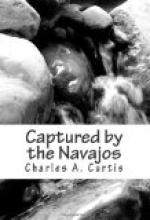“November 20, 1863.
“Lieutenant,—Message
received, and the messenger fed.
Corporal Coffey and
eight men leave here at 10.15 P.M.
“James Mulligan, Sergeant.”
“Come here, little doggie,” said Sergeant Cunningham. “If we get out of this, the company shall pay for a silver collar and a medal of honor for the finest dog in the army.”
“If that detail marches at the regulation gait of three miles an hour,” I said, “it should be here by a quarter-past one, and it is now a quarter to twelve.”
My anxiety over our prospects was so great I neglected to show proper gratitude to our devoted messenger.
“The men will do better than that, sir, if they keep on the road. The trouble will be in finding this trail. They have never been this way.”
“I think the junction of this and the hot-springs trail cannot be far from here. Let’s take a shot at that log every three minutes from now on, and the noise may attract our friends.”
We began firing at once, aiming at the under side of the log where it touched the earth. I am confident this must have sent some sand and gravel into the eyes of the rollers, if it did no other damage.
Two of the trigging-stones we had dropped were soon undermined and sunk, and the log had stopped at the third, less than a hundred yards away. As it came on, the sergeant climbed to the top of the chimney, and shortly afterwards returned with the report that he had seen the prostrate body of a warrior revealed beyond—good evidence that his first shot had been fatal. If the next two stones should be as rapidly removed as the others, we feared the Indians would reach us, unless the rescuing party prevented, at about half-past twelve.
Marked by our periodical shots at the log, the time hurried all too rapidly on, the Indians slowly and surely approaching the cabin.
The third stone disappeared, and the log moved with a louder grating over the gravelly soil to the fourth and last obstacle, about thirty yards away, and paused.
“I believe, lieutenant,” said Cunningham, “I could hit those fellows’ legs now from the chimney.”
“All right, sergeant. Close your door and go up and try it,” I replied. “A redskin with a broken leg can do us as little injury as one with a broken head.”
The words were hardly spoken and the sergeant had barely reached the fireplace, when, as if in anticipation of this movement, two figures leaped over the end of the log nearest the perpendicular rock, ran to the corner formed by the cabin and the wall, and by the aid of the dovetailed ends of the logs clambered quickly to the roof. I sent a shot at them, but it had no effect.
No sooner had they reached the roof than they threw the flaming brands and coal of our bonfire down the chimney, where they broke into fragments and rolled over the floor, setting fire to the scattered straw and plumes.




